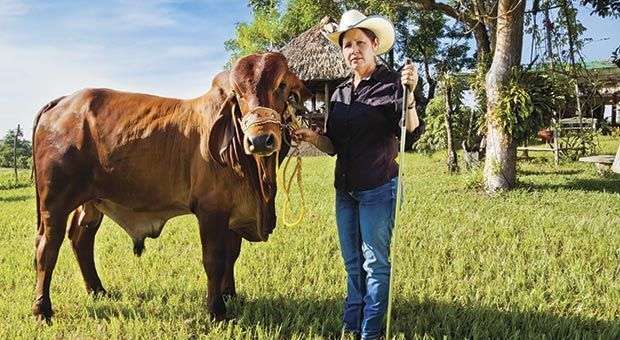At the age of 15, she was an amazona (female rodeo athlete) with the Sancti Spíritus province rodeo team to make her grandfather happy. Later, she earned her degree in pharmacy to please her mother. She was a young professional living in the city when she experienced a terrible sorrow that changed her life’s course and “pulled her to the mountain.”
Her brother Rolando, at only 29 years old, suffered a fatal heart attack. A few years later, her father also died of the same cause. It seemed like their cattle-ranching lineage was disappearing, but Ana Julia Álvarez Rey took over their ranch, Arroyo Hondo: almost five caballerías (116 acres) of land, home to one of the finest herds of the Cebú Bermejo cattle variety in Cuba.
“My grandfather, Gabino Álvarez, was very knowledgeable about cattle breeds. He had a special touch for taking care of the animals, and that was his best legacy to me.”
More than 200 animals now make up the heard of one of the country’s most successful cattle ranches, the winner of awards such as Orgullo Cuba, Excellence for Woman Producers, and Standard Bearer, for its genetic work for obtaining double-purpose animals (meat and milk). Arroyo Hondo also stands out for its conservation of natural resources.
“We have just planted 1,000 timber-yielding trees on the ranch. It was a dream that I shared with my husband Hugo. He oversees training for the farmers so that cattle production does not turn into something that destroys the environment. For years now, we have had a biodigester, we use vermiculture, and we use animal waste as a fertilizer.”
Ana Julia and Hugo Consuegra are a tireless couple. Some say that she wakes up in the dairy and sleeps in the pasture. Thanks to the principles and scientific techniques that they work with, they obtain better output than the local Basic Units of Cooperative Production (coop farms). On a smaller expanse of land and with fewer animals than the state-run ranches, they produce almost 40,000 liters of milk annually.
According to Ana Julia, the issue of genetic improvement in the Cuban ranching industry involves a number of different factors, especially the need to train producers. The practice of massive artificial insemination makes it possible to implement genetic improvement programs that are often unknown. The selection of breeding stock is important for improving the availability of meat and milk.
Before inseminating the females of the heard, the appropriate semen must be studied. At Arroyo Hondo, they use material of optimal quality from resistant, well-adapted varieties. For example, the Holstein is large and strong, with an average weight of 650 kg. According to experts, it is an ideal animal, because it calves before it is three years old, and from then on it calves annually.
Holstein crossed with the Cebú Bermejo breed creates cows that can produce large volumes of milk. However, for these ranchers, this is not the only option for cross-breeding. They also work with Bos Indico, a low-fat but corpulent-looking breed with an active, tenacious temperament.
“At Arroyo Hondo we value the analysis of production figures, which allows us to have the information we need about the potential of each animal. If you were to ask me why Cuban cattle-raising does not take off the way the country’s economic situation needs it to, I would say it’s because we still have our feet in the present and our eyes on the past.”
On her land, intensive grazing was replaced with alternatives for feeding and raising cattle. Cattle roaming in search of food was replaced with techniques such as confining them by area. That way, they avoid fatigue from long wanderings in search of the best pasture. In addition, these ranchers work to ensure highly nutritional feed for the dry season.
The absence of a comprehensive approach often undercuts expected cattle-raising yields in Cuba. Ana Julia Álvarez says a global approach is needed, one that does not exclude the biological, physical, and socioeconomic factors that make up the foundations of any type of production system.
“Taking cattle breeding seriously is a complicated task. You have to study, know how to listen, and love what you do. My husband and I wake up thinking about Neco, an animal that has been admired at ranching fairs by Cuban experts and international judges. We also have a special affection for Frida, the cow with a painter’s name, and I could go on and name every single one of them for you.”
This successful woman has concerns and fears. “Sometimes I think about what will happen if my husband and I are no longer on the ranch. But my country boy’s caresses soon remind me that if I was a pharmacist and I came back to the mountain, then our actress daughter would also come back to Arroyo Hondo if the time should come.”
By: Yeni Fleites
Photos: Alain L. Gutiérrez









